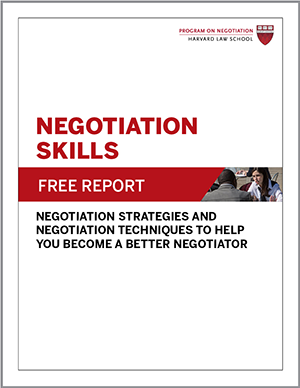
Whether we notice them or not, social norms—the rules of behavior deemed acceptable in society—strongly influence our behavior. We automatically lower our voices when we enter a library and raise them at football games. We arrive at work on time but show up to dinner parties half an hour late. We stop at red lights rather than green lights. Norms keep society running smoothly, help us fit in, and give us a sense of belonging.
Social norms are a powerful force—so powerful, in fact, that you can harness them as influence tactics to improve your negotiated outcomes.
Nudging People toward Better Decisions
In their book Nudge, University of Chicago professor Richard H. Thaler and Harvard Law School professor Cass R. Sunstein explain that we can encourage people to make more rational decisions by anticipating and capitalizing on the cognitive biases that affect all of us, including reliance on social norms.
Our knowledge of cognitive biases can help us design systems that steer, or “nudge,” people toward choices that would benefit them and society, such as saving more for retirement, making healthier food choices, and donating their organs after death.
To take one example, the state of Montana launched an educational campaign to reduce smoking among teenagers. One advertisement revealed that “Most (70 percent) of Montana teens are tobacco free.” By suggesting that not smoking is a more popular choice than smoking, the ad capitalizes on students’ desire to conform to social norms—to fit in. After the campaign was launched, teen smoking decreased significantly in Montana.
Beyond social norms, such “nudges” can capitalize on many other common human tendencies that steer us wrong. For example, researchers have found that inertia and the tendency to stick with the status quo prevent people from contributing adequately to workplace retirement plans. A simple switch—automatically signing up employees to contribute and requiring them to “opt out” to reduce or eliminate their contributions—has significantly increased employees’ savings rates in many organizations.
Majority Rules
Relevant to influence tactics in negotiation, in a 2016 study, UCLA and Tel-Aviv University professor Meirav Furth-Matzkin and Sunstein examined whether social norms could be used to sway people to support certain policies. In survey studies, they presented an identical public policy to hundreds of Americans with diverse political views. Half of the participants were asked to assume that most people supported the policy; the other half were asked to assume that most people opposed it. The policies presented involved nudging citizens toward a certain outcome that could increase the common good, such as presuming consent for organ donation rather than requiring people to sign up to donate—a nudge that has been found to increase organ donation.
When participants were told that most people favored the policy they were presented with, they were more likely to support it than when they were told most people opposed it. For example, 56% supported the organ-donor policy when they thought it was popular, whereas 43% supported it when they thought it was relatively unpopular.
On policies ranging from obesity reduction to improving fuel efficiency, people’s levels of support rose by about 10% when they believed the majority backed rather than opposed them. Although those with firm opinions about an issue were unlikely to be swayed by the majority, those who felt less strongly about it and those who were unsure about what to support were more influenced by the majority opinion.
The results suggest an influence tactic for negotiators: When trying to persuade someone of the merits of a policy or proposal, cite its popularity. That might mean turning in a proposal for family leave to your employer with a petition that’s gone around the office or supplying a negotiating partner with evidence that your offer is in line with expert opinions.
In his book Influence: The Psychology of Persuasion, Arizona State University professor Robert B. Cialdini confirms that we look for “social proof” of a behavior’s correctness when deciding what to do.
Other Effective Negotiation Influence Tactics
The following influence tactics can also be quite persuasive in negotiation:
- Offer limited choices. Because an excess of options can lead to “decision paralysis,” offer your counterpart two or three choices rather than, say, 10 or 20.
- Give your counterpart a “gift.” Look for opportunities to make minor concessions in negotiation, such as letting your counterpart choose the meeting location. Such low-cost gifts are likely to be reciprocated, especially if you label them as concessions and highlight any sacrifice you might be making.
- Unbundle gains; bundle losses. People tend to prefer one large loss over two equivalent smaller losses, psychologists Amos Tversky and Daniel Kahneman found. Conversely, people prefer two small gains over an equivalent large gain. So, dole out your own concessions in stages—but ask for concessions all at once.
What other influence tactics have you found to be useful in your business negotiations?





